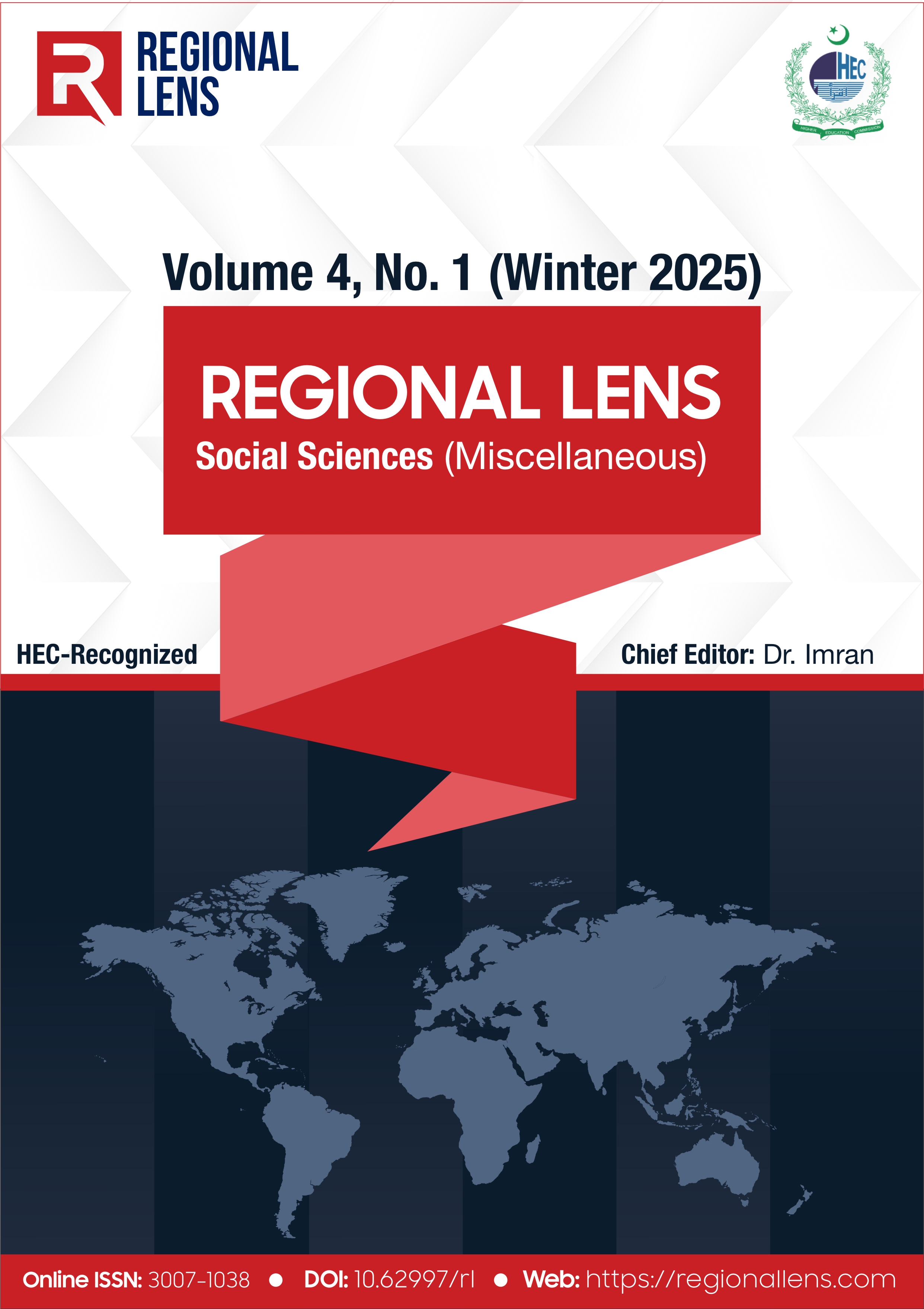Modern vs. Traditional Family Planning Methods: The Role of Spousal Communication in Decision-Making in Khyber Pakhtunkhwa
DOI:
https://doi.org/10.62997/rl.2025.41018Keywords:
Reproductive, Health, Derterminant, Spousal Communications, Traditional and ModernAbstract
Family planning glowing aspect of reproductive health yet its adoption and method selection remain influenced by various socio cultural determinant mainly spousal communications. This study sightsee the role of spousal communication in the choice between traditional and modern family planning methods in Khyber Pakhtunkhwa a region where cultural norms considerably shape reproductive decisions. Using a quantitative approach, the research combines a quantitative survey method and cross-sectional research design while collecting data from married couples in Dir lower and Upper insights from close-ended interviews scheduled to assess the extent and nature of communication between spouses regarding contraception. Using multistage sampling technique to access potential respondent while which yielded a total sample of 768 sizes. Finally data was analyze including univariate statistical technique (frequencies and percentages) and bivariate analysis binary logistic regression was used to explore relationships to test the hypotheses. The findings reveal that a significant majority of respondents are knowledgeable about pregnancy delay methods and actively use family planning techniques. Modern methods dominate and are the most popular, but the couple's reliance is mainly on censuses. Traditional methods are also practiced by a significant minority, with withdrawal being the most common. The important role of communication in FPM adoption is prominent. While discussions about contraceptive use and sexual relations positively influence FPM utilization, conversations on topics like the number of children or equitable decision-making showed unexpected patterns, likely due to socio-cultural dynamics. The research underlines the necessity of joint decision-making with women at the center when addressing reproductive health issues.
References
Alam, H., Riaz, S., & Hussain, S. (2019). Childless Women: Narratives from Khyber Pakhtunkhwa. Pakistan Journal of Women's Studies= Alam-e-Niswan= Alam-i Nisvan, 26(1), 149-168.
Ali, H., Ali, A., & Begum, F. (2024). Utilization of family planning methods among currently married women in Pakistan: Insight from Pakistan Demographic and Health Survey 2017–2018. Health Care for Women International, 45(1), 129-143. https://doi.org/10.1080/07399332.2021.1902527
Ali, S., Khan, R., & Yousaf, M. (2021). Socioeconomic determinants of family planning service utilization in developing regions. Journal of Public Health Studies, 45(3), 120–135.
Ataullahjan, A., Mumtaz, Z., & Vallianatos, H. (2019). Family planning, Islam and sin: Understandings of moral actions in Khyber Pakhtunkhwa, Pakistan. Social Science & Medicine (1982), 230, 49–56. https://doi.org/10.1016/j.socscimed.2019.03.011
Bongaarts, J., & Sathar, Z. (2024). Is Pakistan’s fertility transition stalling? Asian Population Studies, 20(2), 186–202. https://doi.org/10.1080/17441730.2023.2250971
Brown, E., Gul, X., Abbas, A., Nasar, A., & Balal, A. (2017). Men’s perceptions of child-bearing and fertility control in Pakistan: insights from a PEER project. Culture, health & sexuality, 19(11), 1225-1238. https://doi.org/10.1080/13691058.2017.1309459
Kamal, S. M., & Islam, M. A. (2012). Interspousal communication on family planning and its effect on contraceptive adoption in Bangladesh. Asia Pacific Journal of Public Health, 24(3), 506-521. https://doi.org/10.1177/1010539511399118
Creswell, J. W., & Creswell, J. D. (2017). Research design: Qualitative, quantitative, and mixed methods approaches. Sage publications.
Ezeanolue, E. E., Iwelunmor, J., Asaolu, I., Obiefune, M. C., Ezeanolue, C. O., Osuji, A., ... & Ehiri, J. E. (2015). Impact of male partner’s awareness and support for contraceptives on female intent to use contraceptives in southeast Nigeria. BMC Public Health, 15, 1-6. https://link.springer.com/article/10.1186/s12889-015-2216-1
Gupta, N., Katende, C., & Bessinger, R. (2003). Associations of mass media exposure with family planning attitudes and practices in Uganda. Studies in Family Planning, 34(1), 19–31. https://doi.org/10.1111/j.1728-4465.2003.00019.x
Hackett, K., Nausheen, S., Yameen, S., Hussain, I., Khaneez, Z., Shah, I., & Soofi, S. B. (2021). Exploring reasons for low uptake of widely available modern contraceptive methods in Karachi, Pakistan: a mixed-methods study. Journal of Global Health Science, 3(2). https://doi.org/10.35500/jghs.2021.3.e12
Kaur, P., Stoltzfus, J., & Yellapu, V. (2018). Descriptive statistics. International Journal of Academic Medicine, 4(1), 60. https://doi.org/10.4103/ijam.ijam_7_18
Khan, J. (2023). The knowledge, experiences, and barriers associated with male involvement in family planning at Lal Qila, District Dir (Lower), KPK, Pakistan: A descriptive exploratory study (Unpublished master's dissertation). Aga Khan University, Karachi, Pakistan.
Khan, N. U., Asif, N., Zehrh, I., Mg, G., Arshad, S., & Changez, M. I. K. (2024). Fertility patterns in Pakistan: a comparative analysis of family planning trends across different geographic regions. Rural and Remote Health, 24(3), 8835. https://doi.org/10.22605/RRH8835
Madni, A. R. (2017). The influence of advertisements and religious factors on condom use intentions among married male Muslims in Pakistan [Doctoral dissertation, Universiti Utara Malaysia Electronic Theses and Dissertation]. https://etd.uum.edu.my/7013/1/s96014_01.pdf
Mustafa, G., Azmat, S. K., Hameed, W., Ali, S., Ishaque, M., Hussain, W., Ahmed, A., & Munroe, E. (2015). Family planning knowledge, attitudes, and practices among married men and women in rural areas of Pakistan: Findings from a qualitative need assessment study. International Journal of Reproductive Medicine, 2015, 190520. https://doi.org/10.1155/2015/190520
NIPORT. (2013). National Institute of population research and training (NIPORT), Mitra and associates, and ICF international. Bangladesh demographic and health survey 2014.
Population Welfare Department. (2017). History. Punjab.gov.pk.
Reitsma, J. B., Glas, A. S., Rutjes, A. W. S., Scholten, R. J. P. M., Bossuyt, P. M., & Zwinderman, A. H. (2005). Bivariate analysis of sensitivity and specificity produces informative summary measures in diagnostic reviews. Journal of Clinical Epidemiology, 58(10), 982–990. https://doi.org/10.1016/j.jclinepi.2005.02.022
Sarfraz, M. (2020). Understanding factors affecting utilization of Long-Term Reversible Contraception in rural Pakistan (Doctoral dissertation, UNSW Sydney).
Sarfraz, Mariyam, Hamid, S., Rawstorne, P., Ali, M., & Jayasuriya, R. (2021). Role of social network in decision making for increasing uptake and continuing use of long acting reversible (LARC) methods in Pakistan. Reproductive Health, 18(1), 96. https://doi.org/10.1186/s12978-021-01149-0




